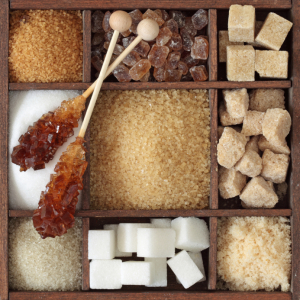Nutrition 3rd Stop: Sugar – What’s All the Fuss?
 Growing up, there did not seem to be so much talk about sugar and well, actually food in general, but now everywhere you turn there is talk about sugar. The high corn syrup scare of 2009 set everyone off on a ‘read the label’ spree and has evolved into a ‘no high fructose corn syrup’ frenzy.
Growing up, there did not seem to be so much talk about sugar and well, actually food in general, but now everywhere you turn there is talk about sugar. The high corn syrup scare of 2009 set everyone off on a ‘read the label’ spree and has evolved into a ‘no high fructose corn syrup’ frenzy.
So, what’s the big deal? Is sugar really bad for you and if so, then why could our parents and we as children eat it without any pandemic effects? As always, there are many reasons.
Food Processing:
Of course, it’s the same old same old. Please forgive my slight diatribe here. It’s processed foods and the super processing of processed foods. Food manufacturers are driven to increase profits and in doing so have a trifecta of:
1. Extending food, both in storage & quantity,
2. Minimizing spoilage potential of ingredients by using additives, pesticides & farming treatments,
3. Seeking the lowest cost ingredients & methods for preparation and distribution.
This mix is leading to an exponential degradation of the nutritional and digestible value of food found in today’s supermarkets. So what was once a loaf of bread in the 1950’s is not the same loaf of bread today.
There are refinement methods that strip the nutrients that our bodies need for digestion and absorption of essential vitamins & minerals. In nature, fruits & grains contain all of the vitamins, minerals, enzymes, protein, fats & fiber that our bodies need to assimilate these foods. When foods are refined, they are stripped of these essentials and our bodies actually need to provide the missing links for digestion. So not only are we not getting the nutrients we need, we are actually stripping our own reserves.
In addition, the quality of ingredients and the soil used for farming those ingredients have eroded over time. Unless organic farming methods are in place, the vitamins and minerals in the soil is vastly different than 50 years ago.
Quantity:
The super sizing of everything has affected our ability to know appropriate portion sizes. The vast quantities available feed into our ancient need for survival. Food is available, so our minds tell us to keep eating as the food may not be available in the future. Sure this goes back thousands of years, but we are coded for survival. We actually have to fight our mind and listen to our bodies for when we are satiated.
Perception:
There is that pesky food pyramid that dates back to the 1960’s. One of the main problems with the pyramid is that it homogenizes foods by type. It basically says that all fats are bad, all carbohydrates are good and all proteins are the same. This is not true as all fats are not bad, all carbohydrates are not good and all proteins are not created equal.
Let’s stay focused on the carbohydrates. Having 6 – 11 servings of carbohydrates every day is too much when including simple carbohydrates such as breads, cereals, crackers and the like. When having complex carbohydrates, you need to include fruits and vegetables and these are separate on the food pyramid. Comprising 6 – 11 servings of carbohydrates without including these two categories is not good nutrition.
The food pyramid is not the only issue with our perception. The advertising industry does a number on us with its constant bombardment of food, restaurant and alcohol advertising. With interactive media, they are now involving the public to vote on the new type of Lay’s potato chip and the new color to add to the M&M package.
Combining this with the packaging of cereals, chips, crackers, cookies and candies, it’s had to resist these colorful ‘delights’.
A friend told me a few years ago that our bodies want fruits and vegetables. She said, ‘Notice when you walk into the grocery store and go into the produce section. Your body will actually quicken, you’ll feel lighter and you will WANT to eat the apples, carrots and green beans. We were made to eat these things. Companies don’t spend millions of dollars advertising to make us want to eat fruits & vegetables, but they HAVE to spend millions of dollars to make us want to eat cookies and candy.’ WOW. (Thanks Melissa.)
Way We Process Sugar:
The way the body processes foods is important to the sugar or glucose levels in your body, so it relates no only to the amount and type of sugar in foods, it also relates to the quantity, timing, and the quality of food you are ingesting. It’s a complex task that our bodies perform every minute of every day. It needs balance and help from our food intake to function properly.
‘The level of glucose in the blood is regulated by a finely tuned mechanism involving insulin secretions from the pancreas and hormones from several glands, including the adrenal glands and the thyroid. ’*
When foods are in their natural state, they are digested slowly and the blood sugar levels remain within a certain range that is healthy for the body. However, when foods are refined, the sugar rushes into the blood and insulin is rushed to keep blood sugar levels in balance. If this happens repeatedly, over time, the system will stop responding as it should.
Minimizing the amount of sugar ingested, combining these complex carbohydrates with proteins and fats and limiting the quantity of food helps the body regulate within this narrow range of appropriate blood sugar.
Refined ‘Sugar’ on the Rise:
Again, why all of the fuss now? When we were young, this did not seem to be such an issue.
Here are a few facts:
- In 1821, the average sugar intake in America was 10 pounds per person per year, now it is 170 pounds per person per year!
- Refined sugars did not exist in the 1600’s and were never available in great quantities until the 20th century.
- In 1922, the first Coca Cola plant was built. The drink contained coal tar derivatives, flavorings and massive amounts of sugar.
- 1960’s – enzyme discovered to make high fructose corn syrup.
- US began using high fructose corn syrup in late 1970’s due to many factors: cost, sugar tariffs and availability. Domestically, sodas contained high fructose corn syrup even as those made internationally still contained sugar.
- Since the 1970’s, manufacturers use of high fructose corn syrup exploded due to the fact that it doesn’t mask flavors, has lower freezing point, lengthens shelf life & retains moisture better. In addition, the corn industry is highly subsidized in the US, so it very cheap.
Today high fructose corn syrup, now known as corn sugar, is used in sodas, fruit drinks, fast foods, candy, cookies, chocolate, cereals, crackers, breads, peanut butter, condiments, tomato sauce, marinades, salad dressings, ice cream, jellies, jams, maple syrup, granola bars, cough syrup, cottage cheese, even yogurt with fruits.
The influx of high fructose corn syrup (HFCS) into everyday foods has helped boost the overall sweetener intake by 19% since 1970. As a result, Americans now eat about 523 more calories each day. And about 76 of those extra daily calories come from sugars and sweeteners like HFCS. At last count in 2003, the U.S. Department of Agriculture estimated that Americans eat 79 pounds of corn sweetener per year—a four-fold increase from 1970. **
Does Refined Sugar Cause Disease?
When consuming too much refined sugar, the body is continually called upon to rush insulin to the blood stream from the pancreas and other hormone glands as well as deplete its own stores of vital vitamins and minerals to aid in digestion. Over time, this can lead to many complications such as; degenerative disease, diabetes, hypoglycemia, allergies, obesity, alcoholism, drug addiction, depression, learning disabilities and behavioral problems.*
So, in a word, yes, refined sugar is a causal factor of disease.
Research Findings:
There have been many, many studies over the years. A few include:
- In 1933, according to the British Medical Journal, research showed increased sugar caused an increase in various disease conditions in school children.
- In 1950’s, British researcher, Yudkin, published findings that excessive use of sugar was associated with: fatty acids in aorta, rise in cholesterol, triglycerides, blood insulin, shrinkage of pancreas, enlargement of liver and adrenal glands.
- Survey of medical journals in 1970’s found sugar as factor causing kidney disease, liver disease, shortened life span, desire for coffee & tobacco, & coronary heart disease.
- Sugar has been cited as root cause of anorexia and easting disorders – Second Opinion, 1995.
- Tumors are known to be huge sugar absorbers.
- Bone loss & tooth decay.
All Sugar is NOT Created Equal:
Compounds:
Simply put, the sugar compounds are fructose, glucose & sucrose (50% of fructose & 50% glucose). Both fructose & glucose are simple sugars. In their natural form, fructose is found in fruit and glucose in starches. They both increase blood sugar, however, when consumed in reasonable amounts and in their natural state, they are not detrimental to your body. Your brain and body need carbohydrates to function, so a no-carb diet is not on the agenda.
Yet one filled with a high level of simple sugars is not either, so no copious quantity of white breads, potatoes, white rice, fruit juices, pastas, crackers, etc.
Types of Sweeteners:
Refined sugars involve: granulated, powered, brown, and raw sugar. High fructose sweeteners involve: processed honey, agave, corn syrup, corn sugar and high fructose corn syrup. Artificial sweeteners are not acceptable either, unfortunately, as there is nothing organic about them and your body does not know how to digest them.
Natural sweeteners such as; stevia, raw honey, organic maple syrup, rapadura, date sugar, molasses, malted grain syrup, sorghum syrup and naturally sweetened jams are acceptable sweeteners. But remember, use sparingly. With sugar becoming so readily available in the past century, we have forgotten that a sweet treat is exactly that – a treat.
What You Can Do:
Here is a table of types of carbohydrates and alternatives. Some of these in the starch section overlap with those recommended in the wheat article posted in August 2012.
|
Carbohydrate |
Good |
Better |
Best |
| Starches | |||
| Pasta |
Whole grain |
Zucchini |
Spaghetti Squash |
| Rice |
Long grain |
Legumes |
Green Beans |
| Crackers |
Baked parmesan crisps |
Baked zucchini crisps |
Cucumber slices |
| Cereals |
Irish Oatmeal |
Plain Greek Yogurt |
Eggs |
| Breads |
Ezekial sprouted grains |
Nori Wraps |
Romaine Lettuce Wraps |
| White Potatoes |
Sweet Potatoes |
Roasted Squash or Turnips |
Mashed Cauliflower or Celery Root |
| Potato Chips |
Baked Plantain Chips |
Raw nuts such as; cashews, almonds, pecans or walnuts |
Kale Chips |
| Sweets |
Homemade dessert using almond flour & natural sweetener |
Organic chocolate |
Fresh fruit |
As mentioned above, combining carbohydrates with proteins and fats is very helpful for digestion and keeping the blood sugar levels lower than if you are eating carbohydrates alone. Also, moderate your quantity intake by eating 3 meals plus 2 snacks per day. If you keep your system fueled throughout the day, you will be less likely to have peaks & valleys in your blood sugar levels.
Always remember, be kind to yourself. Eating healthily is easy and natural for some and more difficult for others. Wherever you are on the eating spectrum, try to go to the next best choice. By continuously improving, your diet will become healthier and you will feel better.
Notes:
* Fallon, Sally, Nourishing Traditions, page 22.
** Pbs.org, The Rise of High-Fructose Corn Syrup.


Really enjoyed reading this one as I practice my new vegan diet. Couldn’t agree more with everything you said above! I haven’t seen anything that said everything that needed to be said better than this post. I wish this was all common sense. That would certainly cut down the healthcare costs and result in happier people in America.
Hey, vegan, huh? How is that going? And, what prompted it?